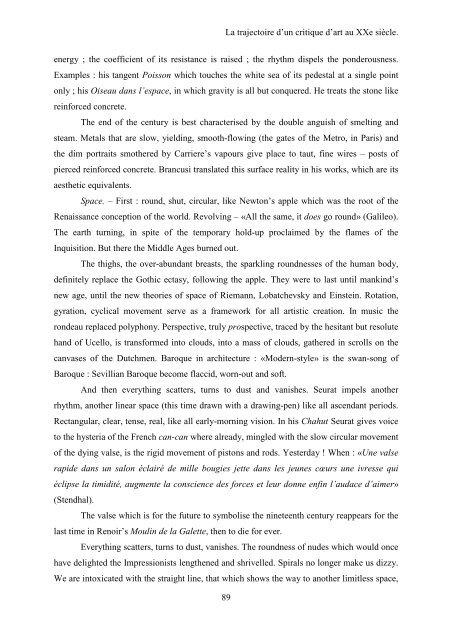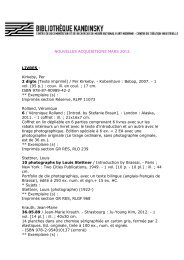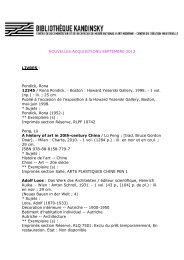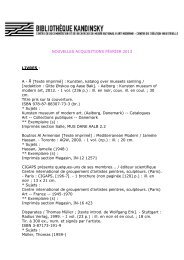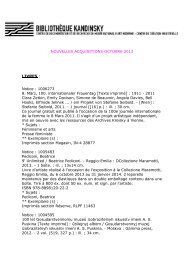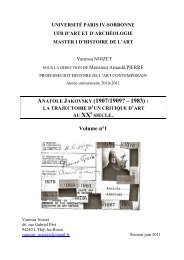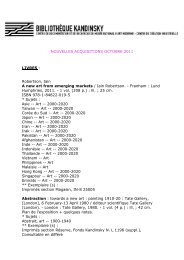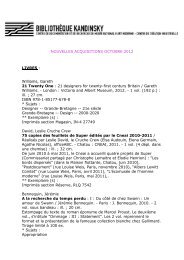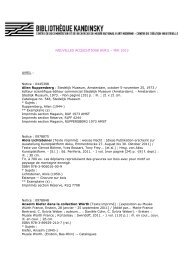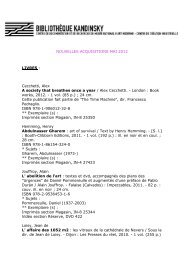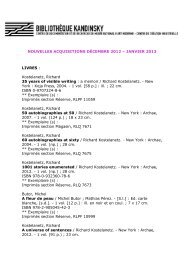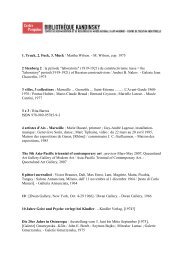anatole jakovsky (1907/1909 ? â 1983) - Bibliothèque Kandinsky
anatole jakovsky (1907/1909 ? â 1983) - Bibliothèque Kandinsky
anatole jakovsky (1907/1909 ? â 1983) - Bibliothèque Kandinsky
You also want an ePaper? Increase the reach of your titles
YUMPU automatically turns print PDFs into web optimized ePapers that Google loves.
La trajectoire d’un critique d’art au XXe siècle.<br />
energy ; the coefficient of its resistance is raised ; the rhythm dispels the ponderousness.<br />
Examples : his tangent Poisson which touches the white sea of its pedestal at a single point<br />
only ; his Oiseau dans l’espace, in which gravity is all but conquered. He treats the stone like<br />
reinforced concrete.<br />
The end of the century is best characterised by the double anguish of smelting and<br />
steam. Metals that are slow, yielding, smooth-flowing (the gates of the Metro, in Paris) and<br />
the dim portraits smothered by Carriere’s vapours give place to taut, fine wires – posts of<br />
pierced reinforced concrete. Brancusi translated this surface reality in his works, which are its<br />
aesthetic equivalents.<br />
Space. – First : round, shut, circular, like Newton’s apple which was the root of the<br />
Renaissance conception of the world. Revolving – «All the same, it does go round» (Galileo).<br />
The earth turning, in spite of the temporary hold-up proclaimed by the flames of the<br />
Inquisition. But there the Middle Ages burned out.<br />
The thighs, the over-abundant breasts, the sparkling roundnesses of the human body,<br />
definitely replace the Gothic ectasy, following the apple. They were to last until mankind’s<br />
new age, until the new theories of space of Riemann, Lobatchevsky and Einstein. Rotation,<br />
gyration, cyclical movement serve as a framework for all artistic creation. In music the<br />
rondeau replaced polyphony. Perspective, truly prospective, traced by the hesitant but resolute<br />
hand of Ucello, is transformed into clouds, into a mass of clouds, gathered in scrolls on the<br />
canvases of the Dutchmen. Baroque in architecture : «Modern-style» is the swan-song of<br />
Baroque : Sevillian Baroque become flaccid, worn-out and soft.<br />
And then everything scatters, turns to dust and vanishes. Seurat impels another<br />
rhythm, another linear space (this time drawn with a drawing-pen) like all ascendant periods.<br />
Rectangular, clear, tense, real, like all early-morning vision. In his Chahut Seurat gives voice<br />
to the hysteria of the French can-can where already, mingled with the slow circular movement<br />
of the dying valse, is the rigid movement of pistons and rods. Yesterday ! When : «Une valse<br />
rapide dans un salon éclairé de mille bougies jette dans les jeunes cœurs une ivresse qui<br />
éclipse la timidité, augmente la conscience des forces et leur donne enfin l’audace d’aimer»<br />
(Stendhal).<br />
The valse which is for the future to symbolise the nineteenth century reappears for the<br />
last time in Renoir’s Moulin de la Galette, then to die for ever.<br />
Everything scatters, turns to dust, vanishes. The roundness of nudes which would once<br />
have delighted the Impressionists lengthened and shrivelled. Spirals no longer make us dizzy.<br />
We are intoxicated with the straight line, that which shows the way to another limitless space,<br />
89


